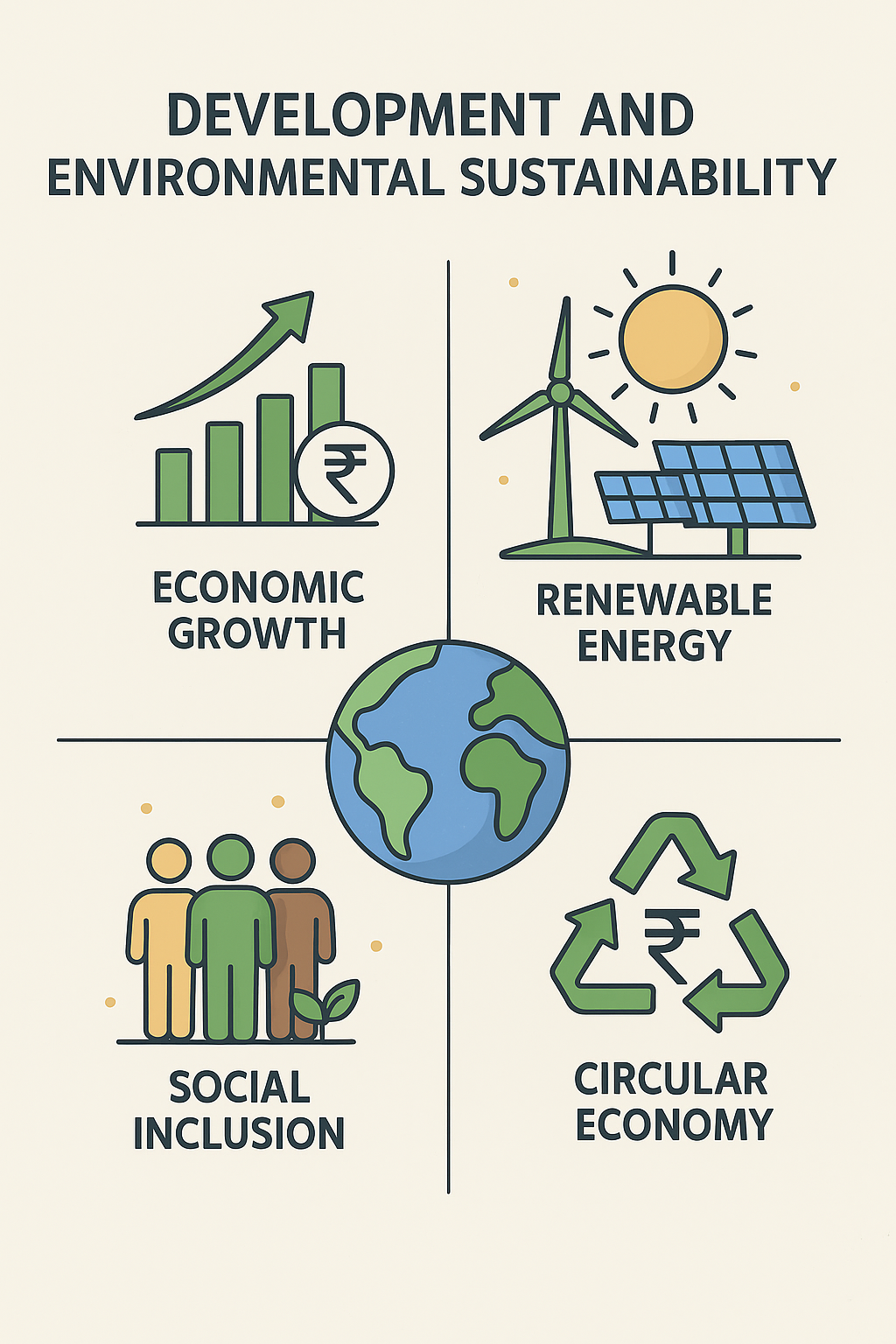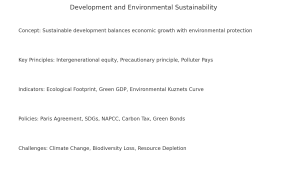
27 Jul Development and Environmental Sustainability
Development and Environmental Sustainability – UPSC Economics Optional Paper 1
Economic development and environmental sustainability are intricately connected. The 21st century poses a critical challenge — how can countries achieve high growth without degrading the planet’s resources? This is the essence of “Development and Environmental Sustainability,” a core topic in Paper 1 of the UPSC Economics Optional syllabus.
📊 Infographic – Development and Environmental Sustainability

development_env_sustainability_infographic
🧠 Mind Map – Environmental Sustainability & Development Framework
development env and sustainability_mindmap
1. Introduction
Sustainable development refers to a model of growth that meets the needs of the present without compromising the ability of future generations to meet their own needs. As defined by the Brundtland Commission (1987), it requires integrating economic, social, and environmental priorities.
2. Core Concepts
- Carrying Capacity: Maximum population size that an environment can sustain indefinitely.
- Environmental Ethics: Philosophical discipline concerning human responsibilities toward nature.
- Natural Capital: Stock of natural resources that provide ecosystem services.
3. Key Principles of Sustainability
- Intergenerational Equity: Responsibility to future generations.
- Precautionary Principle: Avoid irreversible harm even in the face of uncertainty.
- Polluter Pays Principle: Those who produce pollution must bear the cost of managing it.
- Substitutability: Whether man-made capital can substitute for natural capital.
4. Measures and Indicators of Environmental Sustainability
4.1 Green GDP
GDP adjusted for environmental damage and resource depletion. Helps in assessing net welfare gain.
4.2 Genuine Savings
Also called Adjusted Net Savings. Includes gross savings minus depreciation of produced capital, education expenditure, depletion of natural resources, and pollution damage.
4.3 Environmental Kuznets Curve (EKC)
Hypothesizes that environmental degradation first rises and then falls with income growth.
4.4 Ecological Footprint
Measures how much nature we use vs. what Earth can regenerate.
4.5 Planetary Boundaries
Scientific framework outlining ecological limits within which humanity can safely operate.
5. Global Frameworks and Agreements
5.1 Rio Earth Summit (1992)
Resulted in Agenda 21, UNFCCC, CBD (Biodiversity), and UNCCD (Desertification).
5.2 Sustainable Development Goals (SDGs)
UN’s 17 Goals (2015–2030) including climate action, clean energy, water, and sustainable cities.
5.3 Paris Agreement (2015)
Legally binding global treaty to limit global warming below 2°C, ideally 1.5°C. India is a signatory.
5.4 COP Summits
Annual climate conferences under the UNFCCC framework. COP28 emphasized climate finance and adaptation.
6. India’s Environmental Sustainability Initiatives
- National Action Plan on Climate Change (NAPCC) – Includes 8 missions such as Solar Mission, Energy Efficiency, Water Mission, etc.
- CAMPA Fund – For afforestation and forest conservation.
- Faster Adoption and Manufacturing of Hybrid and Electric Vehicles (FAME)
- Green India Mission
- Perform Achieve Trade (PAT) Scheme – Market-based mechanism for energy efficiency.
7. Environmental Economics Theories
7.1 Coase Theorem
If property rights are well-defined, parties can negotiate to resolve externalities without government intervention.
7.2 Pigovian Taxes
Corrective taxes imposed on activities that generate negative externalities (e.g., carbon tax).
7.3 Tradable Permits
Cap-and-trade systems allow market determination of pollution price (e.g., EU-ETS).
Graduation degree with IAS coaching
8. Challenges in Achieving Environmental Sustainability
- Climate Change: Rising temperatures, erratic weather, sea-level rise
- Biodiversity Loss: Sixth mass extinction, habitat destruction
- Resource Depletion: Overuse of fossil fuels, groundwater, forests
- Inequity: Developing countries bear the brunt but contributed less to emissions
- Policy Gaps: Implementation failure, greenwashing, data asymmetry
9. Role of Sustainable Finance
Green bonds, ESG investing, and climate risk assessments are emerging tools for funding sustainable projects.
10. Integration of Development with Sustainability
True development must be sustainable. This requires:
- Decoupling growth from emissions
- Investing in renewable energy and circular economy
- Empowering communities for local sustainability
- Fostering green innovation and sustainable consumption
GS paper 4 syllabus and study plan
GS paper 3 syllabus and study plan
GS paper 2 syllabus and study plan
GS paper 1 syllabus and study plan
📚 Previous Year UPSC Questions (PYQs)
- Examine the relationship between economic growth and environmental sustainability. (2021)
- Discuss the importance of Green GDP and its limitations in measuring national welfare. (2019)
- Critically evaluate the effectiveness of India’s environmental policies. (2020)
🔮 Probable Questions for Upcoming UPSC Prelims & Mains
- What are the major indicators of environmental sustainability? Discuss with reference to India.
- Explain the significance of the Paris Agreement in tackling climate change.
- What are the principles of sustainable development? How are they reflected in India’s development strategy?
- Discuss the role of fiscal instruments in achieving environmental sustainability.




No Comments